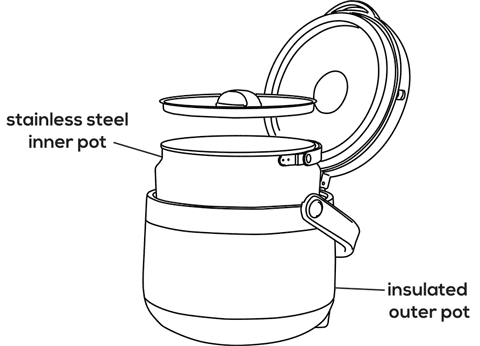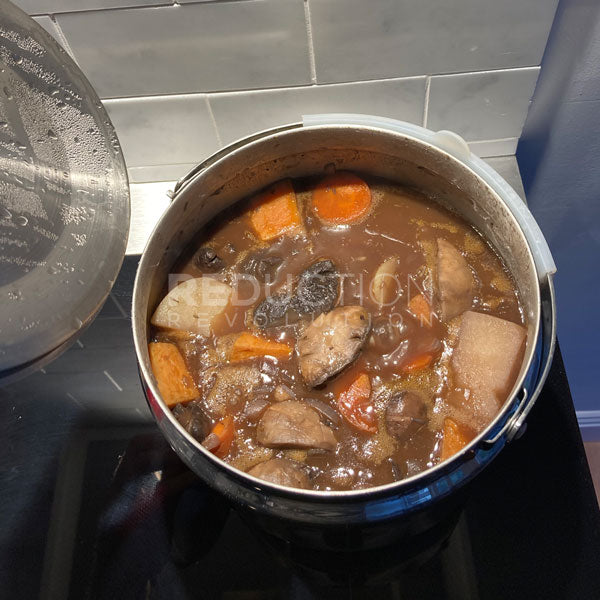Our customers often ask about thermal cooker recipes for the Billyboil.
The good news is you can cook a wide array of existing recipes in a thermal cooker - either as-is or with some minor modifications.
In this article, I'll show you how to turn almost any recipe into a thermal cooker recipe in three simple steps.
Download: Our PDF User Guide for a summary of the advice in this article.
Our thermal cooker comes in two sizes: Billyboil 3L and Billyboil 4.5L. Click the links to find out more.
Billyboil Thermal Cooker Parts & Method
Here's a quick recap of a thermal cooker and how it works. The Billyboil thermal cooker has two main parts:
- The inner pot is similar to a normal stainless steel saucepan. For the initial heat-up phase, you can use it 'like usual' on your existing stovetop.
- The outer pot is a vacuum-insulated container for the inner pot. After your food has been heated through, place the inner pot inside the outer pot and close the lid. Your meal will cook for free using retained heat for up to 12 hours.
The Billyboil reduces your cooking energy consumption by up to 80%. It also saves time, prevents you from burning or boiling over unattended food, and is a much safer way to cook.

Billyboil Thermal Cooker Parts.
Perfect Any Thermal Cooker Recipe in 3 Easy Steps
Step 1: Use the right amount of liquid - not too much, not too little.
Thermal cookers rely on the heated food inside the inner pot to complete the cooking. Covering all ingredients with sauce or liquid will ensure this process can work effectively.
Many recipes - such as most slow cooker recipes - already have enough liquid, so no adjustment is required.
On the other hand, some recipes may need slightly less liquid when adapted to a thermal cooker. For example, recipes that call for extended simmering rely on some of the liquid being boiled off. This will not happen inside a thermal cooker as it is completely sealed.

Stews like this mushroom 'beef bourguignon' are a great thermal cooker recipe.
Step 2: Ensure all ingredients are properly heated through.
This is the most important step when using a thermal cooker, but there's no need to overcomplicate it.
Once taken off the stove, the food will continue cooking at the average temperature of all ingredients. So, if the water or sauce is boiling, but key ingredients have only just been added, they may not be hot enough.
Ideally, bring all the food in the inner pot up to temperature together. Then, let the ingredients boil for a few minutes before placing the inner pot into the outer pot.
Take care with large pieces of meat or vegetables or if some ingredients were frozen when you started. These may require extra initial cooking time.
Step 3: Let it cook for slightly longer than usual.
I use a rule of thumb of one-and-a-half times the standard recipe's cooking time. But the real thermal cooker magic happens if you leave the food in even longer.
The food inside the thermal cooker effectively cooks at the average temperature of its insulated contents. Because this temperature drops slowly over time, you will usually need to extend the cooking time of a regular recipe.

Curries - such as this Dal Makhani - are another dish well-suited to thermal cooking. The Billyboil allows for all that flavour infusion without the usual energy usage (or hassle) of hours-long cooking.
Thermal Cooker Recipe Inspiration & Examples
The Billyboil is particularly well-suited to recipes for slow cookers, Dutch ovens, or similar 'one-pot' meals.
Here are some styles of dishes to try:
- Soups & Stews - Soups, stews, and other dishes that involve simmering or slow cooking are ideal for the Billyboil. The thermal cooker can maintain the heat for hours, allowing the flavours to meld and the ingredients to become tender.
- Braised Dishes - Braising is a cooking technique that involves searing meat or vegetables at a high temperature and then simmering them in a flavourful liquid. The braising can be done in a separate pan or grill or in the base of the inner pot before adding other ingredients.
- Curries - Curries, chilis, and other stew-like dishes that require long simmering times are perfect for the Billyboil. The initial cooking stage allows you to develop the flavours, and then the thermal cooker gently cooks the dish to perfection.
- Grains & Porridges - You can easily prepare rice, oatmeal, congee, and other grains or porridges in a thermal cooker. After heat up, the insulated thermal cooker allows the cooking and absorption to continue without any burning or sticking.
- Bone Broths & Stocks - Making bone broth and stock requires simmering for several hours to extract flavour and nutrients. The Billyboil can efficiently handle this long cooking process, saving energy and time.
- Beans & Legumes - Dried beans and legumes often require long cooking times to become tender - a perfect task for the Billyboil.
- Tough Cuts of Meat - Tougher cuts of meat, such as beef brisket, pork shoulder, or lamb shanks, benefit from long, slow cooking to break down the connective tissues and make the meat tender.
- Various Side Dishes - You can also cook all the basics in a thermal cooker, like pasta, rice, or a side of vegetables. For this reason, many of our customers buy two units: the 3L thermal cooker for the sides and the 4.5L thermal cooker for the main dish.
Watch @Electrify_this's quick two-minute demo of the Billyboil:
Click the image above to play the video in a new window.
Billy Boil Recipes - Troubleshooting & Tips
Here are some tips for you to get the most out of your thermal cooker:
- When bringing ingredients to the boil, use medium to medium-high heat. Using your stove on high is usually less efficient and may cause some ingredients to catch or stick to the bottom the pot.
- The Billyboil's base is only about 20cm wide - use a small 'burner' on your stovetop for effective heat transfer and minimal fuel usage.
- Use common sense - or a food thermometer - to ensure all food in the inner pot is heated through before placing it in the outer pot.
- For rice, porridge, or risotto, use the absorption method cooking instructions. The right amount of water will already be specified.
- To reduce or thicken the sauce in some recipes, you can put the inner pot back on the stove before serving. You can also add cornflour or another starch to your recipe.
- After about 12 hours, the temperature inside the Billyboil may drop below 60˚C. For food safety reasons, you should keep food cooking above this temperature. If you leave food inside the thermal cooker for too long, ensure you reheat it before serving.
- To clean it, use warm, soapy water for the inner pot and wipe the outer pot with a damp cloth. A stainless steel cleaning paste, like Gumption, can remove stubborn marks inside the inner pot.
- Traveling in a caravan or motorhome? Your sink might be the perfect spot to transport the Billyboil and cook as you drive. The outer pot is 25cm wide and fits in most sinks.
- The Billyboil's outer pot lid can be locked closed for cooking and transportation or detached for serving (see below).

Some unique features of the Billyboil.
Want to find out more? See our innovative Billyboil Thermal Cooker.
















